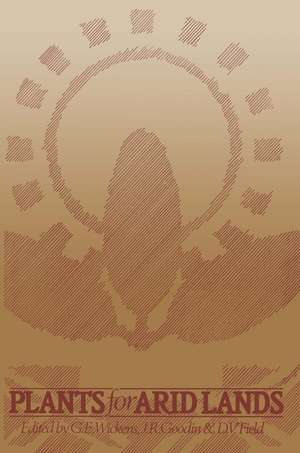Plants for Arid Lands: Proceedings of the Kew International Conference on Economic Plants for Arid Lands held in the Jodrell Laboratory, Royal Botanic Gardens, Kew, England, 23–27 July 1984
Editat de G.E. Wickens, David. V. Field, Joe R. Goodinen Limba Engleză Paperback – 30 iun 1989
Preț: 650.37 lei
Preț vechi: 765.14 lei
-15% Nou
Puncte Express: 976
Preț estimativ în valută:
124.44€ • 129.93$ • 102.100£
124.44€ • 129.93$ • 102.100£
Carte tipărită la comandă
Livrare economică 04-18 aprilie
Preluare comenzi: 021 569.72.76
Specificații
ISBN-13: 9780044453307
ISBN-10: 0044453302
Pagini: 496
Ilustrații: 496 p.
Dimensiuni: 155 x 235 x 25 mm
Greutate: 0.69 kg
Ediția:1985
Editura: SPRINGER NETHERLANDS
Colecția Springer
Locul publicării:Dordrecht, Netherlands
ISBN-10: 0044453302
Pagini: 496
Ilustrații: 496 p.
Dimensiuni: 155 x 235 x 25 mm
Greutate: 0.69 kg
Ediția:1985
Editura: SPRINGER NETHERLANDS
Colecția Springer
Locul publicării:Dordrecht, Netherlands
Public țintă
ResearchCuprins
Background.- 1. The needs of the people.- 2. The arid environment.- Food.- 3. Wild desert relatives of crops: their direct uses as food.- 4. Crops for arid lands.- 5. The nutritional composition of Australian Aboriginal food plants of the desert regions.- 6. Khoisan Food plants: taxa with potential for future economic exploitation.- 7. Food plants of prehistoric and predynastic Egypt.- Timber, Fuel and Forage.- 8. Place and role of trees and shrubs in dry areas.- 9. Prosopis tamarugo in the Chilean Atacama — ecophysiological and reforestation aspects.- 10. Forage and fuel plants in the arid zone of North Africa, the Near and Middle East.- 11. Forage and browse — the northern Australian experience.- 12. Bees and honey in the exploitation of arid land resources.- Plants for the Environment.- 13. Economic halophytes — a global review.- 14. Present and potential economic usages of palms in arid and semi-arid areas.- 15. Plants for conservation of soil and water in arid ecosystems.- 16. Nitrogen fixation in arid environments.- National Studies.- 17. The potential for the commercial utilization of indigenous plants in Botswana.- 18. Ecodevelopment of arid lands in India with non-agricultural economic plants — a holistic approach.- 19. Sonic indigenous economic plants of the Sultanate of Oman.- 20. The ecological role of plant resources in the arid regions of China.- 21. Plants of the Australian arid zone — an undeveloped potential.- Work of the Royal Botanic Gardens, Kew.- 22. Wild and semi-cultivated legumes as potential sources of resistance to bruchid beetles for crop breeders: a study of Vigna/Phaseolus.- 23. Seed banks: a useful tool in conservative plant evaluation and exploitation.- 24. The potential for the in vitro preparation of a number of economicallyimportant plants for arid areas.- Biochemicals.- 25. Gums and resins, and factors influencing their economic development.- 26. Resins from Grindelia: a model for renewable resources in arid environments.- 27. Plant hydrocarbon resources in arid and semi-arid lands.- 28. Unconventional arid land plants as biomass feedstocks for energy.- 29. Rubber and phytochemical specialities from desert plants in North America.- Information Services.- 30. Plant information service for economic plants of arid lands.- Taxonomic index.- General index.





